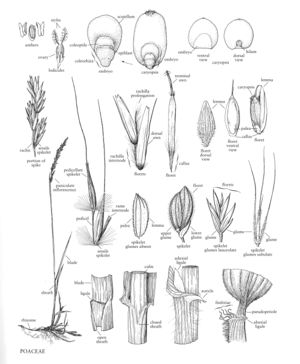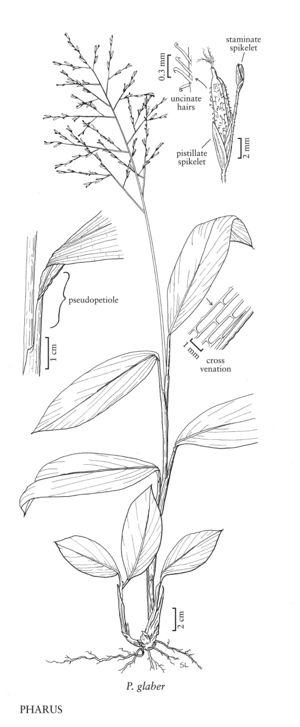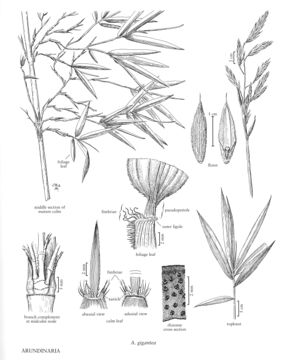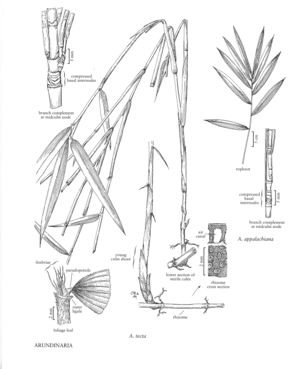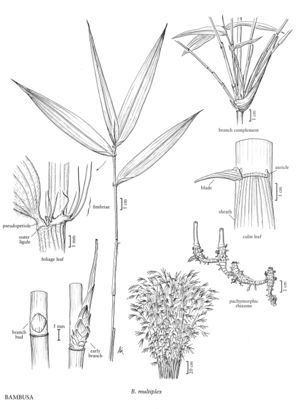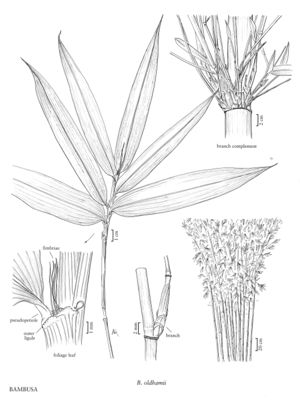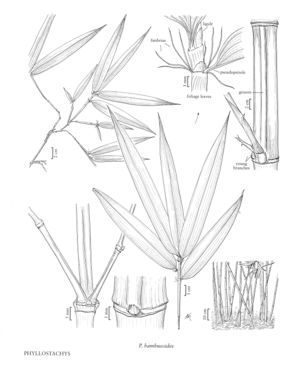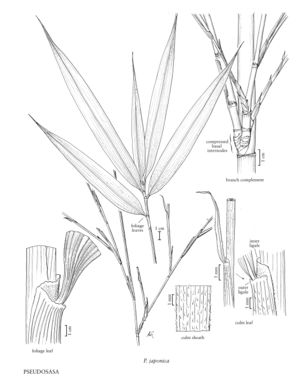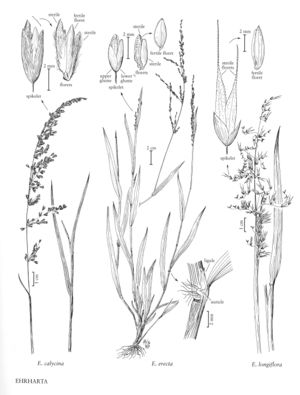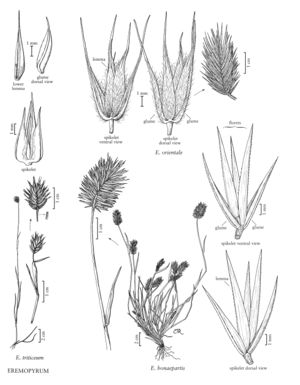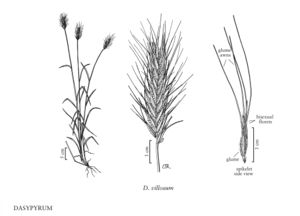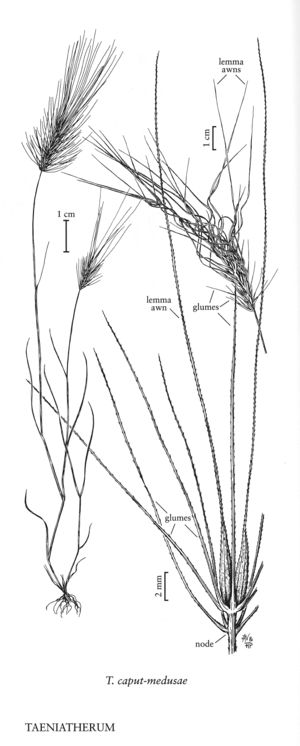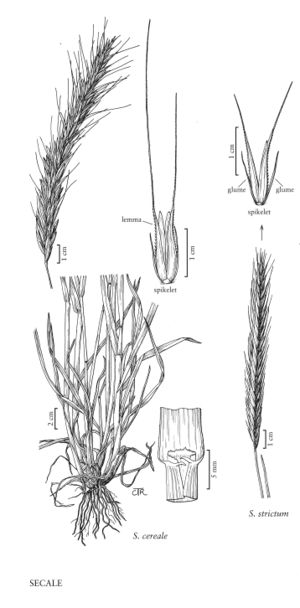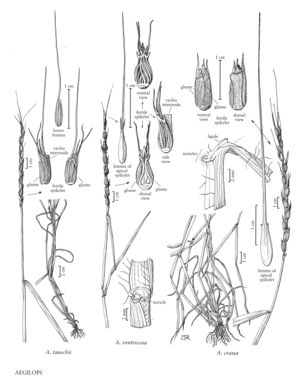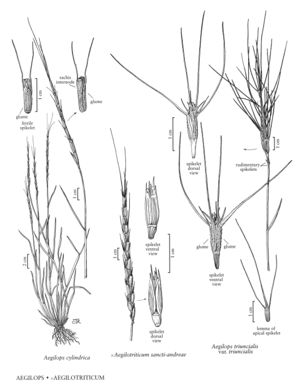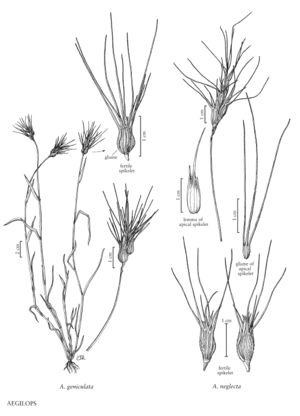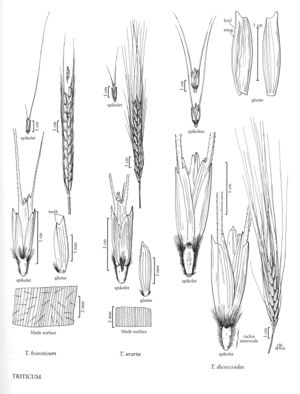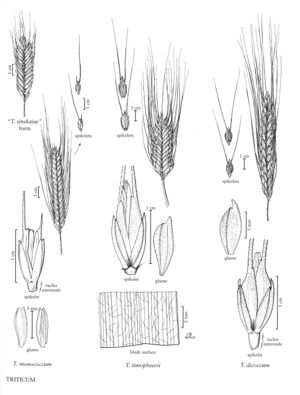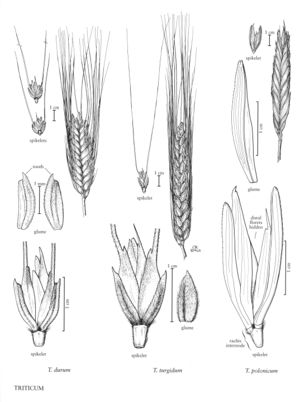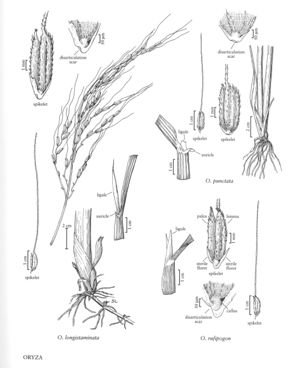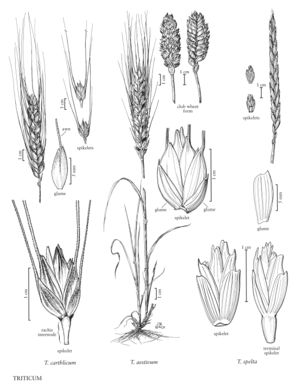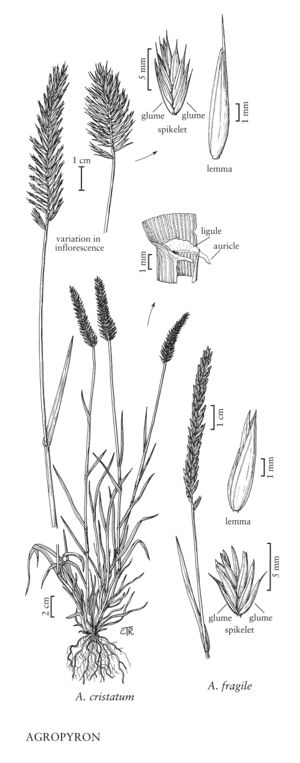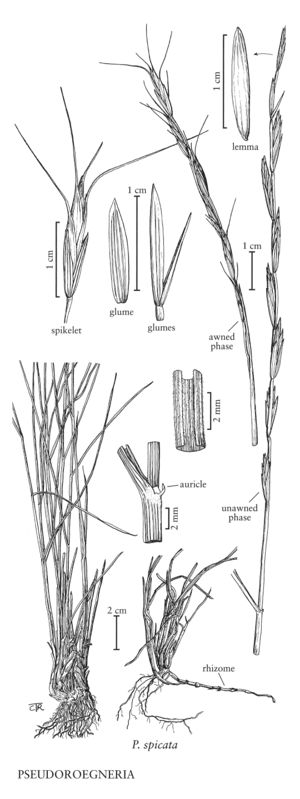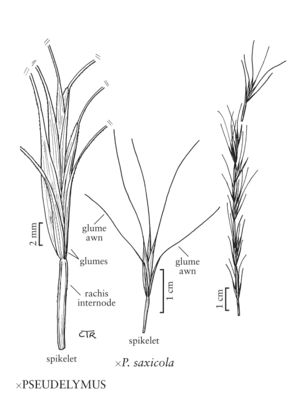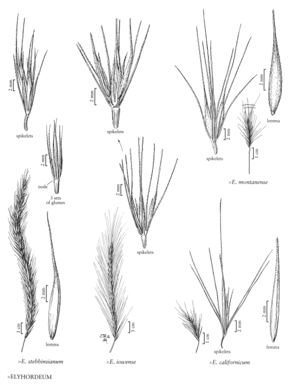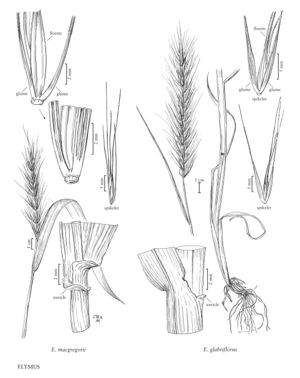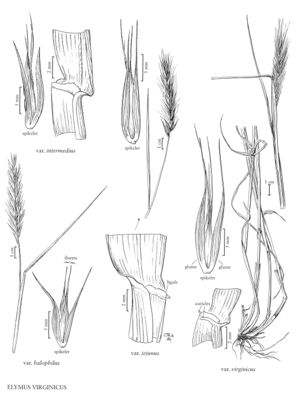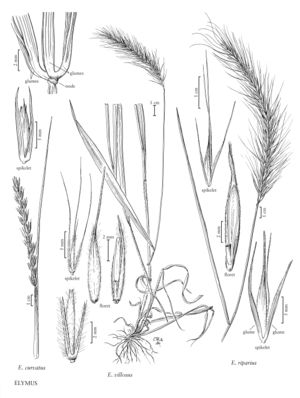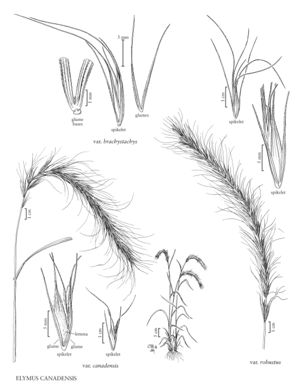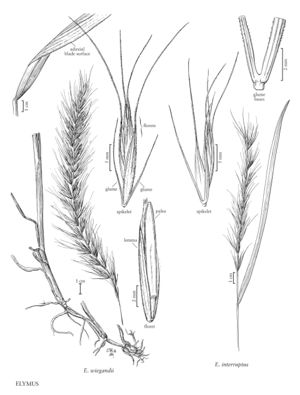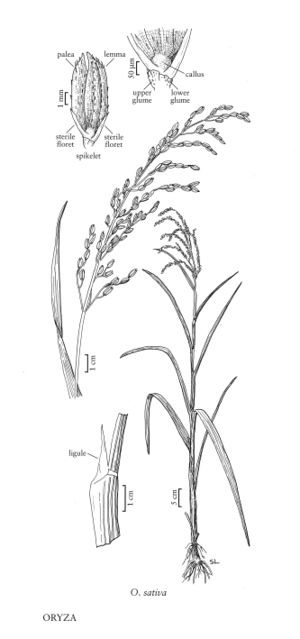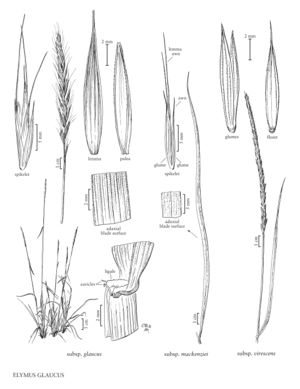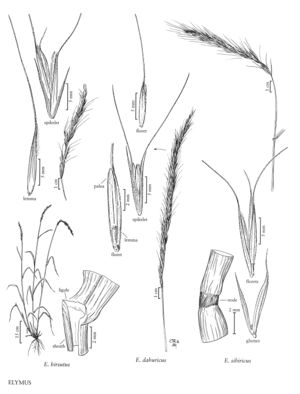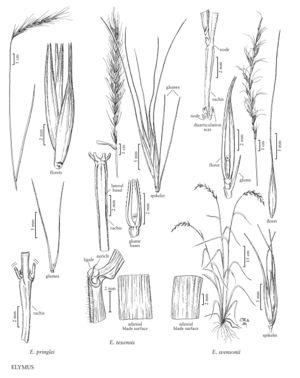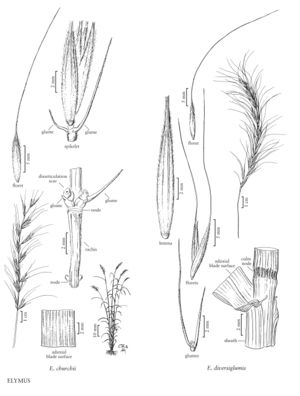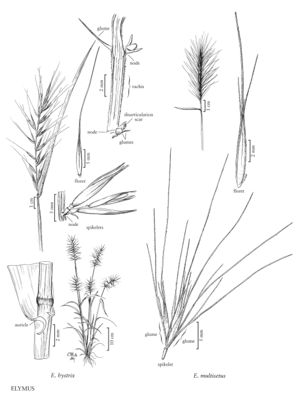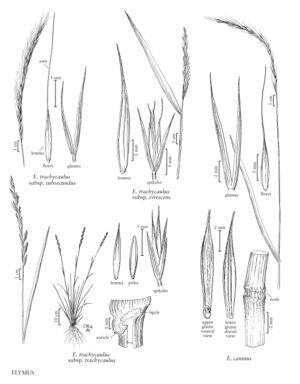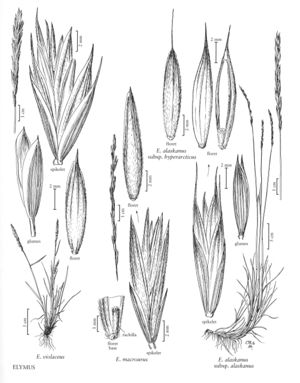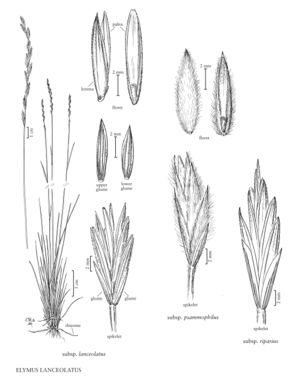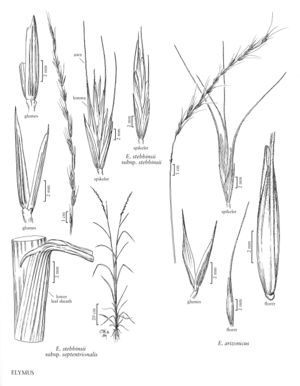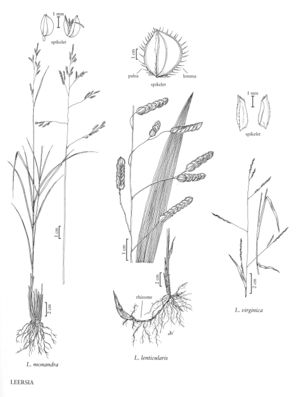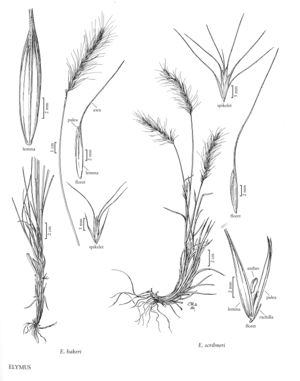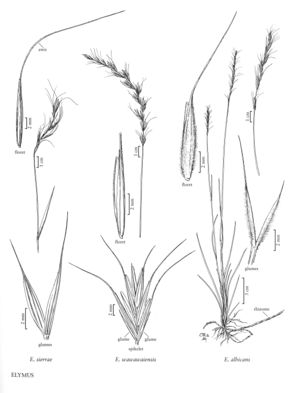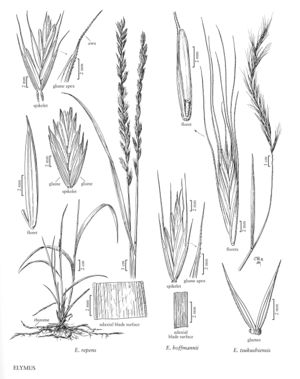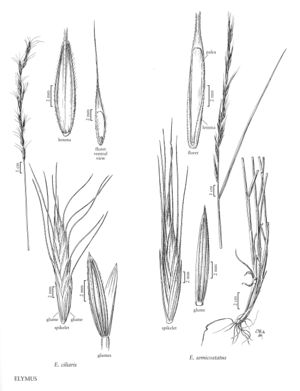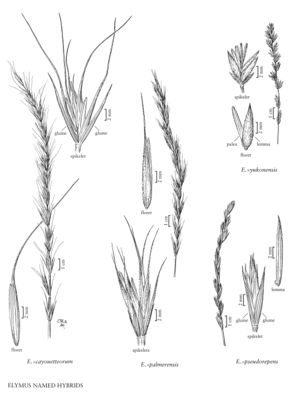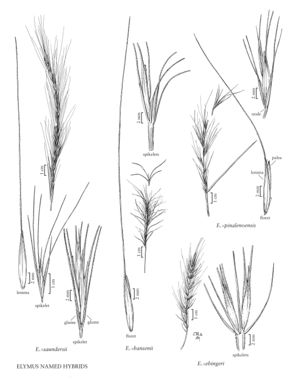Poaceae
Plants annual or perennial; usually terrestrial, sometimes aquatic; tufted, mat-forming, cespitose, pluricespitose, or with solitary culms (flowering-stems), rhizomes and stolons often well developed. Culms annual or perennial, herbaceous or woody, usually erect or ascending, sometimes prostrate or decumbent for much of their length, occasionally climbing, rarely floating; nodes prominent, sometimes concealed by the leaf-sheaths; internodes hollow or solid, bases meristematic; branching from the basal nodes only or from the basal, middle, and upper nodes; basal branching extravaginal or intravaginal; branching from the upper nodes intravaginal, extravaginal, or infravaginal. Leaves alternate, 2-ranked, each composed of a sheath and blade encircling the culm or branch; sheaths usually open, sometimes closed, the margins fused for all or part of their length; auricles (lobes of tissue extending beyond the margins of the sheaths on either side) sometimes present; ligules usually present at the sheath-blade junction, particularly on the adaxial surface, abaxial ligules common in the Bambusoideae, membranous, sometimes ciliate, adaxial ligules usually present, of membranous to hyaline tissue, a line of hairs, or a ciliate membrane; blades usually linear to lanceolate, occasionally ovate to triangular, bases sometimes pseudopetiolate (having a petiolelike constriction), venation usually parallel, sometimes with evident cross-veins, occasionally divergent. Inflorescences (synflorescences) usually compound, composed of simple or complex aggregations of primary inflorescences, aggregations paniculate, spicate, or racemose or of spikelike branches, often with an evident rachis (central axis), primary inflorescences spikelets, pseudospikelets, or spikelet equivalents; inflorescence branches usually without obvious bracts. Spikelets with (0-1) 2 (3-6) glumes (empty bracts) subtending 1-60 florets, glumes and florets distichously attached to a rachilla (central axis); pseudospikelets with bud-subtending bracts below the glumes. Glumes usually with an odd number of veins, sometimes awned. Florets bisexual, staminate, or pistillate, usually composed of a lemma (lower bract) and palea (upper bract), lodicules, and reproductive organs, often laterally or dorsally compressed, sometimes round in cross-section; lemmas usually with an odd number of veins, often awned, bases frequently thick and hard, forming a callus, backs rounded or keeled over the midvein, awns usually 1 (-3), arising basally to terminally; paleas usually with 2 major veins, with 0 to many additional veins between the major veins, sometimes also in the margins, often keeled over the major veins; lodicules (0) 2-3, inconspicuous, usually without veins, bases swelling at anthesis; stamens usually 3, sometimes 1 (2) or 6+, filaments capillary, anthers versatile, usually all alike within a floret, sometimes 1 or 2 evidently longer than the others; ovaries 1-loculed, with (1) 2-3 (4) styles or style-branches, stigmatic region usually plumose. Fruits caryopses, pericarp usually dry and adhering to the seed, sometimes fleshy or dry and separating from the seed at maturity or when moistened; embryos ⅕ as long as to almost equaling the caryopses, highly differentiated with a scutellum (absorptive organ), a shoot with leaf primordium covered by the coleoptile (shoot sheath), and a root covered by the coleorhiza (root sheath); hila punctate to linear. x = 5,6, 7, 9, 10, 11, 12.
Discussion
The Poaceae or grass family includes approximately 700 genera and 11,000 species (Chen et al. 2006). The two grass volumes in this series treat 10 subfamilies, 25 tribes, 236 genera, and 1373 species. Of these, all the subfamilies, 22 tribes, 136 genera, and 892 species are native to the Flora region; 2 tribes, 78 genera, and 290 species have become established in the region. The remaining taxa include ornamental species; species grown for research purposes; species that, if introduced to the region, would pose a threat to important agricultural species; and a few waifs, i.e., species that have been found in the region but have not become established. Most of the waifs are species that were found on ballast dumps near ports around the turn of the last century.
Grasses constitute the fourth largest plant family in terms of number of species. Nevertheless, the family is clearly more significant than any other plant family in terms of geographic, ecological, and economic importance. Grasses grow in almost all terrestrial environments, including dense forests, open deserts, and freshwater streams and lakes. There are no truly marine grasses, but some species grow within reach of the highest tides.
In addition to being widely distributed, grasses are often dominant or co-dominant over large areas. The importance of such areas to humans is reflected in the many words that exist for grasslands, words such as meadow, palouse, pampas, prairie, savanna(h), steppe, and veldt. Not surprisingly, given their abundance and prevalence, grasses are of great ecological importance as soil stabilizers and as providers of shelter and food for many different animals.
The economic importance of grasses to humans is almost impossible to overestimate. The wealth of individuals and countries is dependent on the availability of such sources of grain as Triticum (wheat), Oryza (rice), Zea (corn or maize), Hordeum (barley), Avena (oats), Secale (rye), Eragrostis (tef), and Zizania (wild rice). Most countries invest heavily in research programs designed to develop better strains of these grasses and the many other grasses that are used for livestock, soil stabilization, and revegetation. Developing improved grasses for recreation areas, such as playing fields, golf courses, and parks, is also a major industry in many parts of the world; increasing recognition of the aesthetic value af grasses is reflected in their prominence in horticultural catalogs.
There are, of course, grasses that are considered undesirable, at least in some parts of the world, but even the most obnoxious grasses may be well-regarded over a portion of their range. For instance, Bromus tectorum (cheatgrass) is a noxious, fire-prone invader of western North American ecosystems; it is also welcomed as a source of early spring feed in some parts of the Flora region. Cynodon dactylon (bermudagrass) is listed as a noxious weed in some jurisdictions; in others it is valued as a lawn grass.
Although grasses are widespread and often dominant in open areas, all evidence points to an origin of the family in forests, most likely in the Southern Hemisphere, at least 55-70 mya (Grass Phylogeny Working Group 2001). Recent evidence from phytoliths (isolated silica bodies commonly produced inside the epidermal cells of grasses and some other plants) embedded in fossil coprolites strongly suggests that grasses evolved earlier in the Cretaceous than previously thought (Prasad et al. 2005). Living representatives of the three earliest lineages of the grass family, together comprising about 30 species, are perennial, broad-leaved plants of relatively small stature, native to tropical or subtropical forests in South America, Africa, southeast Asia, some Pacific Islands, and northern Australia. The major diversification of the family probably occurred in the mid-Cenozoic, and was associated with climatic changes that produced more open habitats. All major lineages of the grass family were present by the middle of the Miocene (Jacobs et al. 1999), and C4 photosynthesis in grasses had evolved by then, as well.
Molecular and morphological data unequivocally support a single origin for the Poaceae (Grass Phylogeny Working Group 2001). The caryopsis, a single-seeded, usually dry and indehiscent fruit with the pericarp usually strongly adherent to the seed, and the laterally positioned, highly differentiated embryo are unique to grasses. Beyond the three early-diverging lineages (Anomochlooideae Potztal, Pharoideae, and Puelioideae L.G. Clark et al.), the great diversity of grasses can be divided into two major lineages: the BEP clade (Bambusoideae, Ehrhartoideae, and Pooideae); and the PACMCAD clade (Panicoideae, Arundinoideae, Chloridoideae, Micrairoideae Pilger, Centothecoideae, Aristidoideae, and Danthonioideae, i.e., the PACCAD clade of volume 25 plus the Micrairoideae, support for recognition of which was obtained after publication of that volume). Relationships among the BEP grass lineages remain uncertain, and some evidence points to the Pooideae as being more closely related to the PACMCAD clade than to the Bambusoideae or Ehrhartoideae. The PACMCAD clade includes all known C4 or warm-season grasses.
The closest relatives of the Poaceae lie within a group of six families, all native primarily to the Southern Hemisphere: Joinvilleaceae Toml. & A.C. Sm., Ecdeiocoleaceae D.F. Cutler &c& Airy Shaw, Restionaceae R. Br., Centrolepidaceae Endl., Anarthriaceae D.E Cutler &c& Airy Shaw, and Flagellariaceae Dumort. (Poales Small, sensu stricto). Joinvilleaceae, Ecdeiocoleaceae, and Poaceae constitute a three family clade, with Ecdeiocoleaceae probably being closer than Joinvilleaceae to the Poaceae (Bremer 2000; Bremer 2002; Michelangeli et al. 2003). Rudall et al. (2005), based on a study of reproductive structures in the Ecdeiocoleaceae, suggest that the grass caryopsis may represent "one end of a transformation series embodied by the reduced gynoecial structure and indehiscent fruit of other Poales such as Flagellaria and Ecdeiocolea" (p. 1441).
Selected References
Lower Taxa
Illustrations
Key
Key to Tribes
| 1 | Leaf blades with divergent veins; spikelets unisexual and dimorphic, the pistillate lemmas with uncinate hairs (Pharoideae; FNA 24:11) | Phareae |
| 1 | Leaf blades with parallel veins; spikelets bisexual, unisexual, or modified into plantlets, the pistillate lemmas never with uncinate hairs. | > 2 |
| 2 | Culms perennial, woody or herbaceous, often developing complex branching systems from the upper nodes; leaves on the upper portion of the culms, or distal on the branches, usually pseudopetiolate (Bambusoideae). | > 3 |
| 3 | Culms woody, to 30 m tall; leaves strongly dimorphic, those of the main culms (culm leaves) with expanded sheaths and often with reduced, non-photosynthetic blades, those of the branches (foliage leaves) with abaxial ligules; blades of the distal leaves not folding at night or under stress; florets bisexual; plants native or introduced, often cultivated (FNA 24:15) | Bambuseae |
| 3 | Culms herbaceous, to 3.5 m tall or climbing; leaves not strongly dimorphic; blades of the distal leaves often folding at night or under stress; florets unisexual; plants known only in cultivation in the Flora region (FNA 24:29) | Olyreae |
| 2 | Culms usually annual, sometimes facultatively perennial, rarely woody, sometimes branching from the upper nodes but the branching system not complex; leaves usually not pseudopetiolate. | > 3 |
| 4 | Spikelets almost always with 2 florets, the lower florets in the spikelets always sterile or staminate, frequently reduced to lemmas, occasionally missing, the upper florets bisexual, staminate, or sterile, unawned or awned from the lemma apices or, if the lemmas bilobed, from the sinuses; glumes membranous and the upper lemma stiffer than the lower lemma, or both florets reduced and concealed by the stiff to coriaceous glumes; rachilla not prolonged beyond the second floret (Panicoideae, in part). | > 5 |
| 5 | Glumes flexible, membranous, the lower glumes usually shorter than the upper glumes, sometimes missing, the upper glumes usually subequal to or exceeded by the upper floret; lower lemmas membranous; upper lemmas usually coriaceous to indurate, sometimes membranous; upper paleas similar in texture; spikelets usually single or in pairs, occasionally in triplets and all pedicellate, often shortly so) (FNA 25:353) | Paniceae |
| 5 | Glumes stiff, coriaceous to indurate, often subequal, at least 1 and usually both exceeding the upper floret (excluding the awn); both lemmas hyaline; paleas hyaline or absent; most spikelets in pairs or triplets, at least 1 spikelet in each group usually sessile; pedicels shorter or only a little longer than the sessile spikelets (FNA 25:602) | Andropogoneae |
| 4 | Spikelets either with other than 2 florets or, if with 2, the lower floret bisexual or the upper floret awned from the back or base of the lemma, or the spikelets bulbiferous; glumes usually membranous; lemmas scarious to indurate; rachilla sometimes prolonged beyond the distal floret. | > 5 |
| 6 | Spikelets with 1 floret; lemmas terminating in a 3-branched awn (the lateral branches sometimes greatly reduced); callus well developed; ligules usually of hairs, sometimes ciliate membranes, the cilia longer than the membranous base (Aristidoideae; FNA 25:314) | Aristideae |
| 6 | Spikelets with more than 1 floret or, if only 1, the lemma not terminating in a 3-branched awn; callus development various; ligules various. | > 7 |
| 7 | Spikelets with 1 sexual floret or the spikelets bulbiferous; glumes absent or less than ¼ as long as the adjacent floret; lower glumes, if present, without veins, upper glumes, if present, veinless or 1-veined. | > 8 |
| 8 | Upper glumes present, 1-veined; lower glumes absent or much shorter than the upper glumes and lacking veins (Pooideae, in part; FNA 24:57) | Brachyelytreae |
| 8 | Both glumes absent or lacking veins. | > 9 |
| 9 | Inflorescences 1-sided spikes; triangular in cross section, [Pooideae, in part; FNA 24:62) | Nardeae |
| 9 | Inflorescences panicles; spikelets laterally compressed or terete. | > 10 |
| 10 | Culms aerenchymatous, 20-500 cm long; plants of wet places, often emergent, sometimes floating; lemmas of the bisexual or pistillate florets 3-14-veined; paleas 3-10-veined (Ehrhartoideae, in part; FNA 24:36) | Oryzeae |
| 10 | Culms not aerenchymatous, 2-300 cm tall; plants of wet or dry habitats but not emergent or floating; lemmas of the bisexual or pistillate florets 1-3-veined; paleas 2-veined. | > 11 |
| 11 | Culms 2-19 cm tall; plants of cold or damp habitats, not rhizomatous; sheaths of the flag leaves closed for at least 1/2 their length; caryopses exposed at maturity (Pooideae, in part; FNA 24:378) | Poeae |
| 11 | Culms 5-300 cm tall; plants usually of warm or dry habitats, often rhizomatous; sheaths of the flag leaves open to the base; caryopses not exposed at maturity (Chloridoideae, in part; FNA 25:14) | Cynodonteae |
| 7 | Spikelets usually with more than 1 sexual floret; usually with 2 glumes, 1 or both glumes often longer than ¼ the length of the adjacent floret and/or with more than 1 vein, always longer in taxa with 1 sexual floret. | > 8 |
| 12 | Lemmas unawned, flabellate or with (5)7-15 awnlike teeth (Chloridoideae, in part). | > 13 |
| 13 | Plants not viscid, usually perennial; ligules present, composed of hairs (FNA 25:285) | Pappophoreae |
| 13 | Plants viscid annuals; ligules absent (FNA 25:290) | Orcuttieae |
| 12 | Lemmas awned or unawned, lanceolate, rectangular, or ovate, apices entire, mucronate, bilobed, or bifid, occasionally 4-lobed or 4-5-toothed, sometimes erose. | > 13 |
| 14 | Cauline leaf sheaths closed for 1/2 their length or more; glumes usually exceeded by the distal florets, sometimes greatly so (Pooideae, in part). | > 15 |
| 15 | Spikelets 5-80 mm long, not bulbiferous; lemmas usually awned, often bilobed or bifid, veins convergent distally; ovary apices hairy (FNA 24:193) | Bromeae |
| 15 | Spikelets 0.7-60 mm long, sometimes bulbiferous; lemmas often unawned, not both bilobed/bifid and with convergent veins; ovary apices usually glabrous. | > 16 |
| 16 | Lemma veins (4)5-15, usually prominent, parallel distally; spikelets 2.5-60 mm long, not bulbiferous (FNA 24:67) | Meliceae |
| 16 | Lemmas veins 1-9, often inconspicuous, usually convergent distally; spikelets 0.7-18(20) mm long, sometimes bulbiferous (FNA 24:378) | Poeae |
| 14 | Cauline leaf sheaths open for at least 1/2 their length; glumes exceeding or exceeded by the distal florets. | > 15 |
| 17 | Spikelets with 1 floret; lemmas terminally or subterminally awned, the junction of the awn and lemma conspicuous; rachillas not prolonged beyond the base of the floret (Pooideae, in part; FNA 24:109) | Stipeae |
| 17 | Spikelets with 1-60 florets; lemmas unawned or awned, awns basal to terminal, if terminal or subterminal, the lemma-awn junction not conspicuous; rachillas often prolonged beyond the base of the distal floret. | > 18 |
| 18 | Ligules, at least of the flag leaves, of hairs, a ciliate ridge or membrane bearing cilia longer than the basal ridge or membrane; leaves usually hairy on either side of the ligule; auricles absent. | > 19 |
| 19 | Lemmas of the fertile florets with 3-11 inconspicuous veins, never glabrous, if with 3 veins, pilose throughout or with transverse rows of tufts of hair, if with 5-11 veins, the margins pilose proximally, the hairs not papillose-based; lemma apices usually bilobed or bifid and awned or mucronate from the sinus, if acute to acuminate, the lemmas pilose; awns twisted proximally (Danthonioideae; FNA 25:298) | Danthonieae |
| 19 | Lemmas of the fertile florets usually with 1-3 conspicuous veins, sometimes with 3 inconspicuous veins or 5-11 veins, often glabrous, if with 3 veins, usually glabrous throughout or hairy over the veins, sometimes the margins with papillose-based hairs; lemma apices acute to obtuse, bilobed, or 4-lobed, often mucronate or awned from the sinuses; awns usually not twisted. | > 20 |
| 20 | Lemmas 1-11-veined, veins glabrous or hairy, margins without papillose-based hairs; rachillas and calluses not pilose, sometimes strigose or strigulose; basal internodes of the culms not persistent, not swollen and clavate (Chloridoideae, in part; FNA 25:14) | Cynodonteae |
| 20 | Lemmas 3(5)-veined, veins glabrous, margins sometimes with papillose-based hairs; rachillas or calluses pilose or the basal internodes of the culms persistent, often swollen and clavate (Arundinoideae, in part; FNA 25:7) | Arundineae |
| 18 | Ligules membranous, if ciliate, the cilia shorter than the membranous base; leaves usually glabrous on either side of the ligule; auricles present or absent. | > 19 |
| 21 | Inflorescences panicles or unilateral racemes, not spikelike, without spike-like branches; spikelets solitary, the lowest 0-4 florets in a spikelet sterile or staminate, the distal florets sexual. | > 22 |
| 22 | Spikelets with (1)2-25 bisexual florets; all lemmas similar in size and shape; glumes and lemmas membranous (Centothecoideae). | > 23 |
| 23 | Culms 35-150 cm tall; spikelets with (2)3-26 florets, including the lowest (0)1-4 sterile or staminate florets; lower glumes (1)2-9-veined (FNA 25:344) | Centotheceae |
| 23 | Culms 150-400 cm tall; spikelets with 2-4 florets, including the lowest sterile floret; glumes 0-1-veined (FNA 25:349) | Thysanolaeneae |
| 22 | Spikelets with 1 bisexual or unisexual floret; lemmas of the sterile florets usually differing in size and shape from those of the sexual floret; glumes membranous, lemmas of the sexual florets firmer. | > 23 |
| 24 | Lemmas of the lower florets coriaceous, at least the upper exceeding the sexual floret (Ehrhartoideae, in part; FNA 24:33) | Ehrharteae |
| 24 | Lemmas of the lower florets membranous, often both much shorter than the sexual floret, sometimes subequal to it, sometimes only 1 sterile floret present (Pooideae, in part; FNA 24:378) | Poeae |
| 21 | Inflorescences panicles, racemes, or spikes; spikelets sometimes in pairs or triplets, sterile florets, if any, distal to the bisexual or pistillate florets. | > 22 |
| 25 | Lemmas with 1-3 or 9-11 conspicuous veins; sheaths open; blade cross sections with Kranz leaf anatomy (Chloridoideae, in part; FNA 25:14) | Cynodonteae |
| 25 | Lemmas with (1)3-15 often inconspicuous veins, if with 3 conspicuous veins, the sheaths closed; sheaths open or closed; blade cross sections without Kranz leaf anatomy. | > 26 |
| 26 | Inflorescences spikes or spikelike; spikelets 1-5+ per node, at least 1 spikelet sessile or subsessile (Pooideae, in part). | > 27 |
| 27 | Upper glumes 5-9-veined; spikelets subsessile and solitary at the nodes; auricles absent (FNA 24:187) | Brachypodieae |
| 27 | Upper glumes 1-5-veined; spikelets 1-5+ per node, usually at least 1 sessile at each node, sometimes highly reduced branches present; auricles present or absent. | > 28 |
| 28 | Inflorescences with 1-5 spikelets at a node, if 3, usually with 1 sessile and 2 pedicellate spikelets, if 1, the spikelet tangential to or embedded in the rachis, with 2 glumes, the glumes facing each other; ovaries with hairy apices; auricles often present (FNA 24:238) | Triticeae |
| 28 | Inflorescences spikelike panicles with highly reduced branches, or spikes with spikelets radial to the rachises and all but the terminal spikelet with only 1 glume, or spikes with spikelets tangential to the rachises and having 2 glumes adjacent to each other; ovaries with glabrous apices; auricles usually absent (FNA 24:378) | Poeae |
| 26 | Inflorescences panicles, with no sessile spikelets. | > 27 |
| 29 | Caryopses with a thick pericarp forming a distinct apical knob or beak at maturity; lemmas 3(5)-veined (Pooideae, in part; FNA 24:64) | Diarrheneae |
| 29 | Caryopses usually with a thin pericarp, never with a distinct apical beak or knob; lemmas 3-9-veined. | > 30 |
| 30 | Glumes subulate, stiff; lemmas unawned or with awns to 4 mm long (Pooideae, in part; FNA 24:238) | Triticeae |
| 30 | Glumes lanceolate, membranous; lemmas awned or unawned, awn length varied. | > 31 |
| 31 | Rachillas hairy, hairs 2-3 mm long; lemmas coriaceous; plants established in California, sometimes cultivated as ornamentals (Pooideae, in part; FNA 24:109) | Stipeae |
| 31 | Rachillas glabrous to hairy, hairs shorter than 2 mm; lemmas membranous to coriaceous; plants native, established, or cultivated. | > 32 |
| 32 | Leaves to 2 cm wide, usually not conspicuously distichous; culms 0.01-2.75 m tall, usually less than 1 cm thick (Pooideae, in part; FNA 24:378) | Poeae |
| 32 | Leaves 2-10 cm wide, often conspicuously distichous; culms 2-10(15) m tall, often more than 1 cm thick. | > 33 |
| 33 | Lower cauline blades disarticulating, upper cauline blades forming a flat, fan-shaped arrangement (Panicoideae, in part; FNA 25:352) | Gynerieae |
| 33 | Lower cauline blades persistent, upper cauline blades not forming a flat, fan-shaped arrangement (Arundinoideae, in part; FNA 25:7) | Arundineae |
"decumbent" is not a number.
